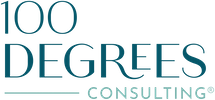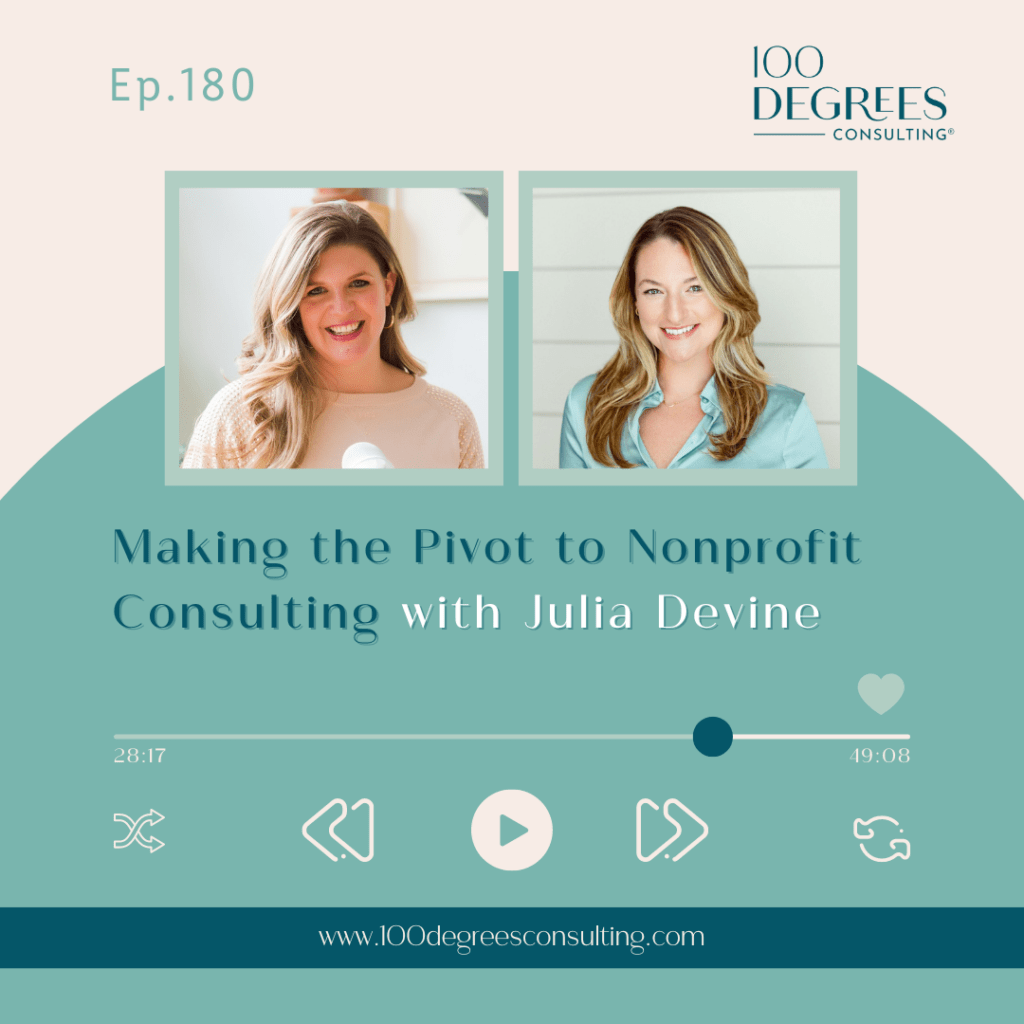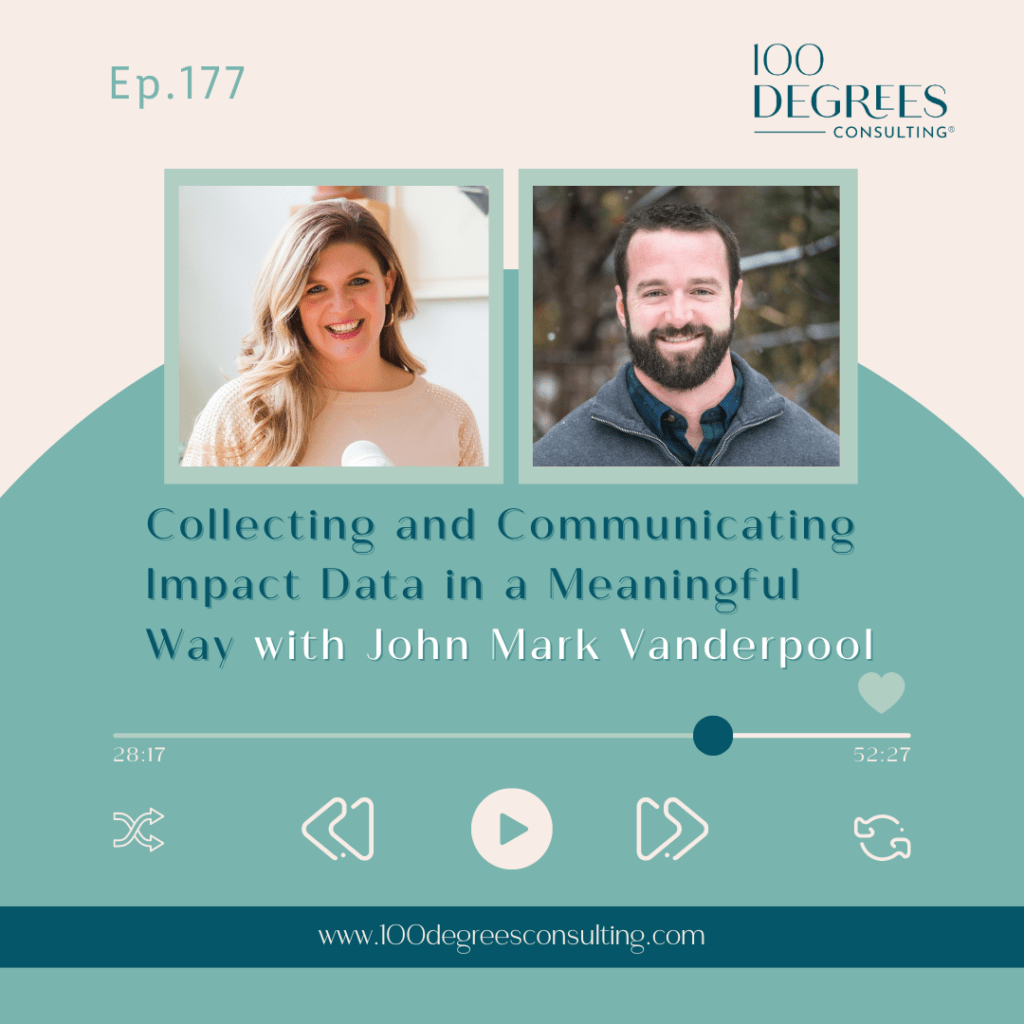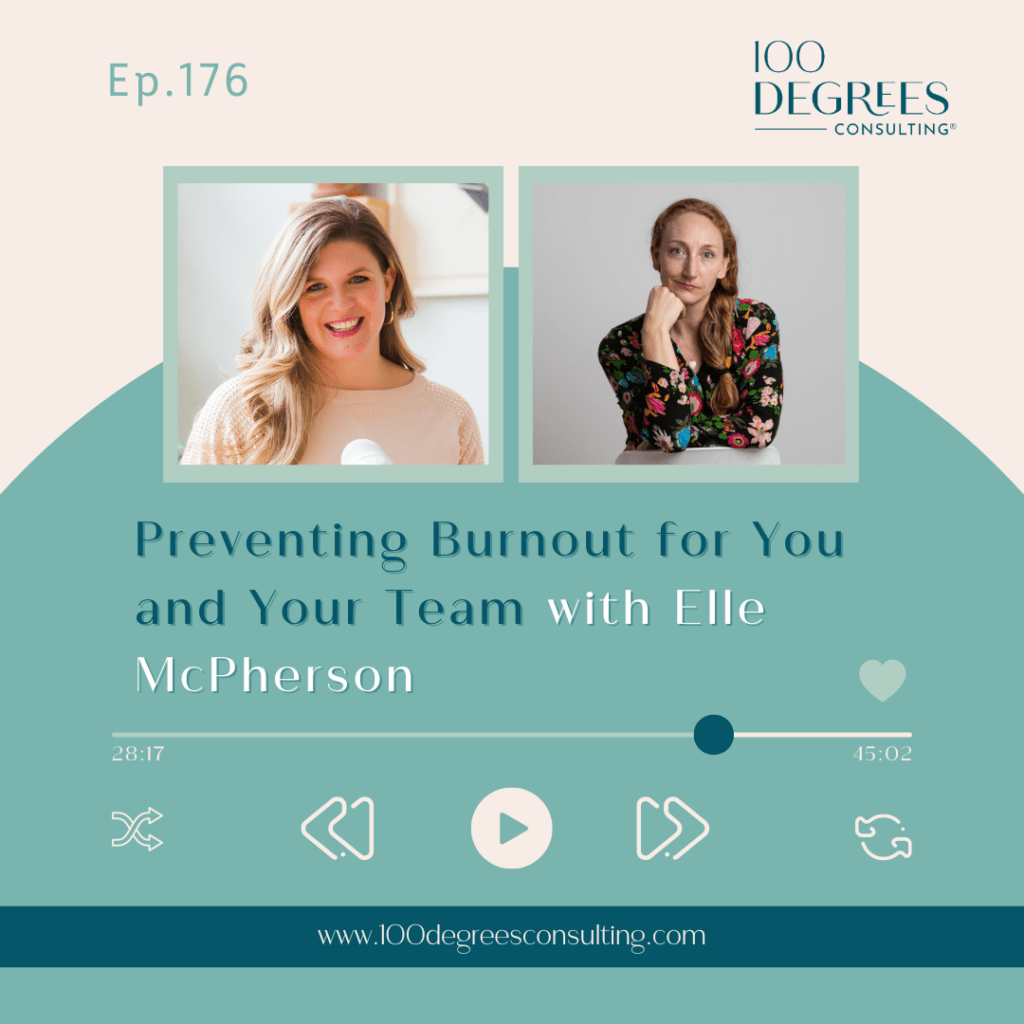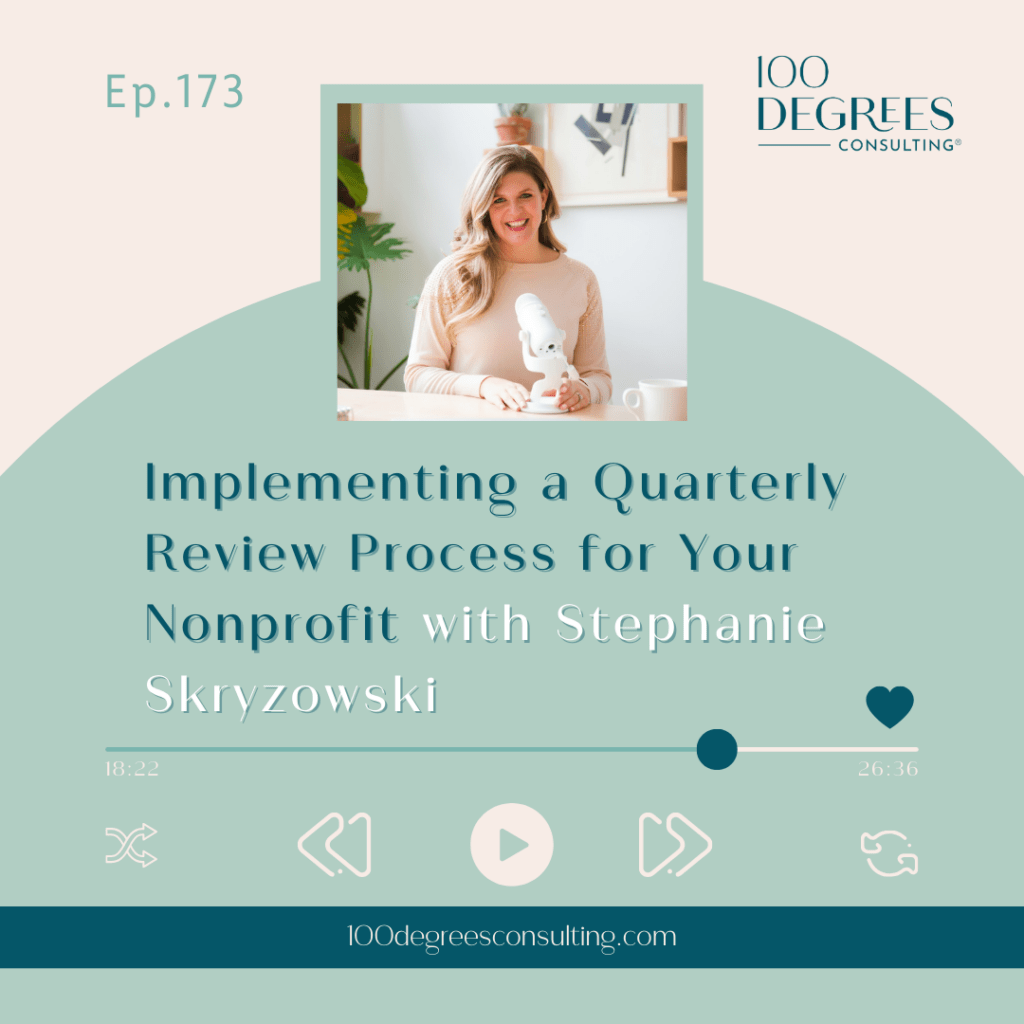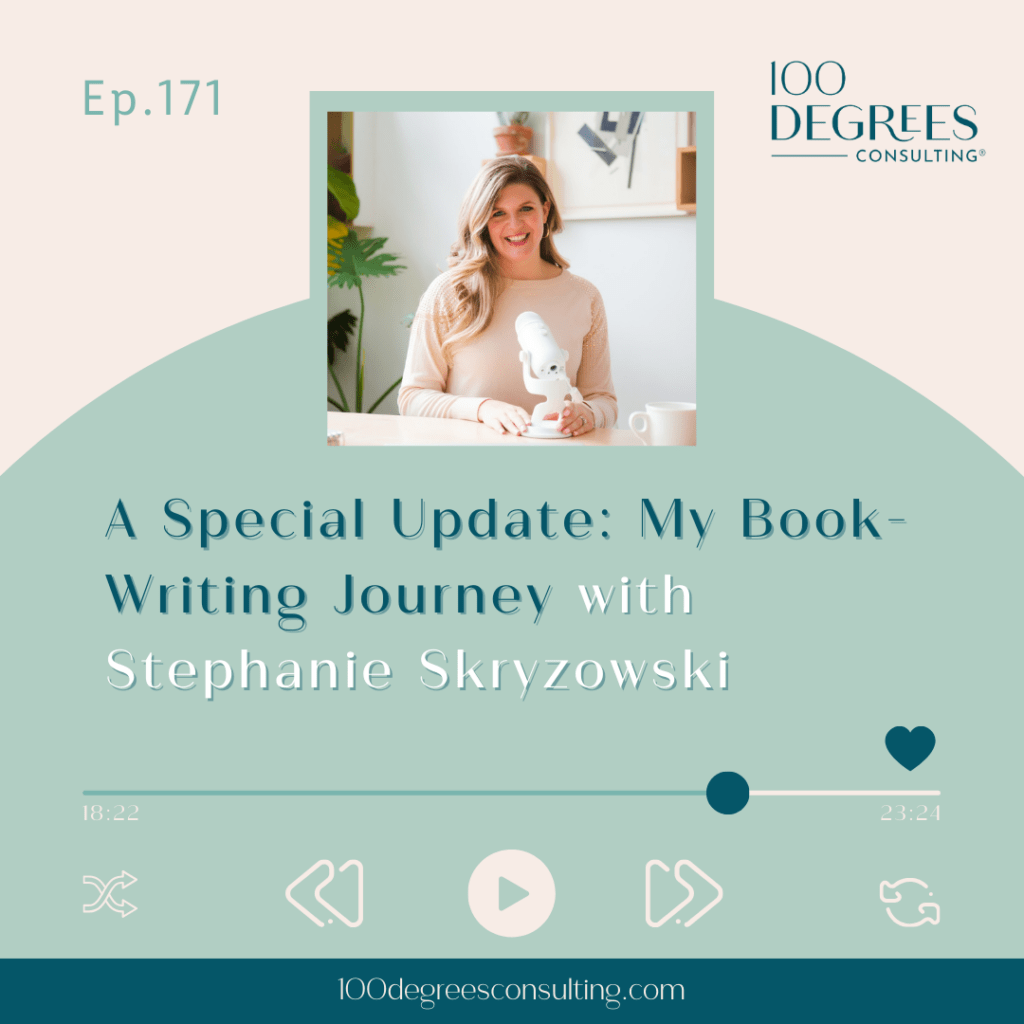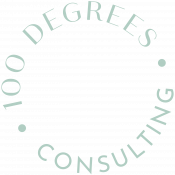Transcript Episode 151 – Disrupting the Status Quo in Your Organization on The Prosperous Nonprofit
Stephanie Skryzowski: [00:00:00] Welcome to the Prosperous Nonprofit, the podcast for leaders who are building financially sustainable and impactful nonprofits and changing the world. I’m Stephanie Skrzewski, a chief financial officer and founder and CEO of 100 Degrees Consulting. My personal mission is to empower leaders to better understand their numbers, to grow their impact and their income.
On this show, we talk to people who are leading the nonprofit sector in new. Innovative, disruptive, and entrepreneurial ways creating organizations that fuel their lives, their hearts, and their communities. Let’s dive in.
Hey everybody, welcome back to the Prosperous Nonprofit. Stephanie here. And today I’m talking to Heather Hiscox. So Heather and I were introduced by a mutual friend months ago, and we’re just now getting the opportunity to meet each other [00:01:00] virtually and to have this conversation. And I’m really excited because we are focusing on two different things on this call together.
The first is her book and her framework and the way that she. She supports nonprofit organizations, as well as government and philanthropic foundations. And we’re also
Heather Hiscox: talking about her online
Stephanie Skryzowski: talk show. Yes, online talk show. So let me give you her bio before we go into the interview with Heather.
Heather Hayes Cox is a frustrated change maker on a mission to change the way we change the world. Heather is the founder and CEO of Pause for Change. The pause method is a proven and proprietary framework. That helps change makers address difficult challenges and pursue promising opportunities. Now listen up friends, listen to this and you will be totally convinced that you need to go buy her book, learn about Heather and implement this framework.
Okay, these skills help organizations be certain about which solutions will create the greatest [00:02:00] impact while using fewer resources. Okay, so we’re talking certainty about solutions, creating the greatest impact, fewer resources, and less time, right? I’m sold. Heather’s the author of No More Status Quo, a proven framework to change the way we change the world.
She’s also the co creator and host of The Possibility Project, an online conversation series in growing community of disruptive change makers, reclaiming their power through meaningful sparks, connections, and action. Tyler speaks at conferences and events about social impact, disruption, and innovation, and has launched several ventures that benefit the social impact sector.
Connecting organizations to the training skills and resources they need to deepen their impact. So I’m really excited for you to learn about both her PAWS framework and the incredible impact that this can have on an organization looking to create social change. As well as possibility project, her online talk show.
Yes. Online talk show where she’s [00:03:00] also building community and having challenging and interesting and disruptive conversations with other leaders inside and outside the nonprofit sector. So Heather is a change maker in all senses of the word. She’s fantastic. and I’m really excited for you to meet her.
So without further ado, let’s go talk to Heather.
Hey everybody, welcome back to the Prosperous Nonprofit, and I’m really excited to be here today with Heather Hiscox. Heather, welcome. Hello. Thank
Heather Hiscox: you for having me.
Stephanie Skryzowski: Yes. So we have just spent the first 15 minutes of our time together, kind of getting to know each other, but I’m excited that we have now hit record so that all of our listeners can get to know you as well.
I would love if you would tell us a little bit about you and about your journey, and we’re definitely going to get into all the amazing things that you are doing and working on now, but tell us about the journey. How did you get to where you are now?
Heather Hiscox: [00:04:00] Oh, gosh, that’s a great question and it’s been definitely a winding journey, which I love.
I always tell people, like, nothing’s a straight line in life. We kind of, we even bought and all those things. Um, yeah, I worked a lot in social impact organizations. I also have a master’s in public health. So I spent a lot of years also in health care. I’m running clinical research studies. So that was fascinating.
And, um, and then was involved in community organizing and, you know, work with governments and work within nonprofits working within as staff member, but then as a consultant, so I’ve started 5 businesses over the last 12 years. So then I started getting into like social entrepreneurship and getting really into like lean startup methodologies and lean experimentation and design thinking and all of that and seeing like, oh, okay, that’s interesting to kind of lift my head out of the sector and see what was happening in the for profit and startup, um, Areas, and I just [00:05:00] thought, okay, what it really came down to for me was that I, I wanted to solve my own problem and what I had experienced.
It was really negative when I did work in the social sector, which was really around problem solving. It was around, like, the ways that we chose to design a program, a process, create a policy, the way that we shaped, like, our work practices were so. Outside being evidence informed and and stakeholder informed we I just noticed so many leaders just saying, well, I think we should do it this way.
And they would just create this entire change management approach and just sweep across the whole agency with new changes that were not informed by community or even the internal staff. And then just the, just the blind adoption of best practices. And, um, you know, just going forward with ideas that I saw fail time and again, it caused these ripples of destruction within the culture of organizations.
And I thought there is absolutely a better way. We cannot do this anymore. [00:06:00] So I really created the framework to pause framework to pause skills as a reaction and response to what I had experienced and what I wish I had when I was frustrated working in the sector. So I just took like all my learning from all these different businesses and all my different roles in these different organizations and mushed it into these new set of practices.
Amazing.
Stephanie Skryzowski: Well, it’s so interesting, like everything that you just said, basically taking what you learned as an entrepreneur, as a business owner, and bringing that way of thinking to the nonprofit sector. Because before we started recording, we were talking about your book and the fact that I’m writing a book as well.
And that is basically the premise of my entire book as well, but approaching it from another angle. So anyway, it’s really interesting. What I am seeing is like all of these things I’ve learned as an entrepreneur, like how to take care of myself, how to invest in myself, how to build a team that is really cared for and is supported, how to build a strong [00:07:00] organization with a focus on your financial management and all of these pieces to build a really prosperous business.
So many principles I don’t see happening in the nonprofit sector. And so that is my book. And so it’s just. Yeah. I love that. I love that sort of common thread between our work. Well, the one thing I talk about a lot on this show is I love talking to people who are working in new or innovative or disruptive or entrepreneurial ways and the nonprofit sector who are really shaking things up.
And I think you’re really doing that in your work. So tell me a little bit more either about your work, you know, with pause for change or the possibility project. Well, we’re definitely going to tap into both cause they’re awesome. But pick one and we’ll go from there.
Heather Hiscox: Yeah, it’s great. Again, out of that frustration, I wanted to create really simple, easy to use steps that anyone can use in any type of uncertainty.
So whether it’s like an internal or external challenge, we have these [00:08:00] weird status quo problem solving skills that we just roll out and our organizations have cultures and we have individual styles and habits of how we address problems. And we have to really pause. That’s why I call it the pause skills, because that’s what I was really telling all of my clients to do is like, hold up, time out, take a minute and let’s really think about, you know, what do we need to do differently?
So it’s disruptive in the way that I’m asking individuals and teams and organizations to first pause to identify who is actually impacted by this challenge. Who are the humans inside and outside your organization that will be most impacted? Cause we often don’t do that. We just barrel ahead based on those habits and how we’re rewarded to just like solve, solve, solve, go urgency.
So it’s, it’s pausing to do that. It’s identifying right away. What is the uncertainty? What are our unknowns? So we actually get to celebrate. We don’t have to just act like, well, yeah, we got it all figured out. We get to say, I don’t know this. I [00:09:00] don’t know this. I don’t know this. And I’m curious about this.
And I wish I knew this. Excellent. So that informs the next phase, which is talking to stakeholders. It’s super common sense. We do really detailed one on one interviews. With internal and external stakeholders to get like a 360 perspective about what’s happening related to the challenge and their unique experience and we’re connected to that.
We do a lot of internal work focus on our own bias and our own positionalities so that we can really open our hearts and minds empathetically so we can receive feedback that might actually be in conflict with our own. So we do that organizational level. And then only then after we’ve learned from those most impacted, do we then start to abundantly brainstorm?
Most people go straight to brainstorming. No, no, we wait until we actually have deeply understood what the challenge is. And then we start to identify not just one challenge, so it’s like, or one solution. So it’s make or break. We actually get with maybe 40 or 50 different ideas. And then we [00:10:00] prioritize those different ideas and instead of building the solution, which is the typical way we have an idea, we’re like, go execute implement.
No, we pause yet again. And we actually try to break our solution. We actually try to break it into the component assumptions. What must be true for this solution to actually create value for that stakeholder? And we test those elements of a solution without having to build out the entire idea. And then we make decisions based on that evidence.
So teams that may not have a lot of power or individuals that don’t have a lot of power can go to a decision maker, no matter how command and control they are and say, you know, I thought your idea was brilliant, but we’ve talked to 50 different stakeholders and nobody wants that. Nobody mentioned it.
But instead, we are super awesome and we have seven other ideas where you’ve tested the top 30 assumptions and we know exactly what’s going to work and why. And we need you on board. I’ve never had a single [00:11:00] leader reject that type of data, and I’ve never had an organization not apply with that type of data to a grant application and not be awarded because it is so convincing.
It is so. Deep and rich with the actual information of what will create social change. So we don’t have to waste time resources. We can just get to the change as quickly as possible. And it’s much more efficient, effective in a matter of hours and weeks versus months and years. Hmm. That’s
Stephanie Skryzowski: so, I mean, brilliant.
Love that approach. And it makes so much sense. Yet, you’re right. We’re often just like forging ahead, doing the thing and bulldozing our way through whatever problem we might find. Oh, I was going to ask you, do you find that this process, because there are more steps to it than bulldozing, does it take longer?
You are definitely going to get a better result, but does the process take a long time? And does that like throw people off because they’re like, Oh, why aren’t we moving fast
Heather Hiscox: [00:12:00] enough? It’s actually the opposite. It’s, we go slow to go fast. So, how the model works is I, um, I work to do a lot of prep work with the sponsor or leader within the organization.
I work to form the team. So, I work with a team of people that work all across the organization. So, if it’s a development related challenge, you know, we might have someone from finance, someone from the grant writing team, um, program team legal, you know, we’ll, we’ll have a whole representative of great people to form a team.
And then what we do is we spend two days intensive, two full days going through every single step of the process. So usually by the end of day two, most teams have a very clear signal of what might be a valuable solution because they’ve already done those interviews. They’ve usually interviewed at least 20 people.
They’ve already identified those. Solutions and run some rapid test to test some of those key assumptions. And they’ve already started to practice those presentation skills to influence leaders. So what we do after the two [00:13:00] days is I get to coach those teams for 12 weeks. And so through those 12 weeks.
It’s only about three hours a week of commitment because they are super busy. They already have galas to plan. They already have end of year fundraising. They already have programs to run. We try to just carve out a little bit of time each week where the team connects and then they assign their homework and do that deep work to keep learning.
And I would say with absolute confidence, usually most teams by week six have a very clear idea of exactly what needs to be done. And usually we’re doing some testing around implementation execution that kind of rounds out that 12 week experience and then teams sometimes will opt in for more coaching or they’re usually will send an additional couple of teams because they see such rapid progress on some of these ideas.
or challenges that have just been sitting there and that people have sort of been putting on blinders and avoiding, they finally get to make rapid progress. And they get a lot of great team cohesion, [00:14:00] um, a lot of great team spirit and connectedness that doesn’t usually exist, especially people that don’t get to work together.
And they get that time and space to really focus on learning, which is key. And they get to make that rapid progress. So most organizations will save at least a hundred thousand dollars in resources. And when they air their typical process versus this one, and most of them will use if they find a great idea.
I’ve seen just complete rapid access to funding to successful program implementation execution, short term and long term. So it’s just a way to accelerate your efforts because you’re using new skills.
Stephanie Skryzowski: And is there any type of problem that this framework is best for and or any type of problem that this framework doesn’t really work for?
Heather Hiscox: No, I’m really used to in so many different organizations. I mean, I work with nonprofits, local governments, and philanthropic foundations. So I’ve used it anywhere with the [00:15:00] entire executive team of Girl Scouts of the USA to working with tiny, tiny communities of 3, 000 people. Small, small, rural, pretty isolated border towns working on some nonprofit and community challenges.
Um, I’ve used it with governments right now. I’m working with Um, the city of Hayward in the Bay Area, I just finished working with the State Bar of California who identified a handful of state policy changes they want to create to make legal services more accessible to all Californians. So it really just is for any type of uncertainty.
Any place that you’re like, I don’t know how to address this problem, or what if we could create something amazing to really elevate our work or to address the challenge in a different way, that’s really what it’s for. The only time it doesn’t work, honestly, is when I work with a leader or a sponsor, and it’s usually sometimes not their fault.
They’re very aspirational. They want to be innovative. They want to push those boundaries. And then [00:16:00] I touch on those guardrails a little too much, right? It’s like you said you wanted to relinquish power, but now that this team is telling you that there’s an alternative idea and option, now you’re kind of squashing that.
That’s when there’s challenges. And I learned very early that there are key questions I need to ask early in an engagement before I even will offer a proposal because I find it’s unethical for me to engage in organizations that are led by those people. And so I kind of Spidey sense that I’ve developed where I can get a sense of they’re saying all the right things, but their actions are not going to match their words.
And I don’t jeopardize those staff members. I don’t want to I don’t want to in any way jeopardize or harm community members in any way. So I tend to get a sense of who I will and will not work with. Yeah,
Stephanie Skryzowski: it’s not interesting. It is pretty easy like to get after you’ve talked to enough people and done this long enough.
It’s pretty easy to get a sense of where is [00:17:00] this going to work and who do I not really want to want to work with. That’s so interesting because I’m thinking of applications in my own business that I’m like, Ooh, you know, here I am sitting over here, like spinning my wheels on different challenges within my own company.
I’m like, I think I need to read your book and go through the framework. So. Yeah. Tell us all about the book. No More Status Quo. Tell us all about this and how does this tie into your framework and your consulting work at Paws for
Heather Hiscox: Change? The book has just been like living in like tissues of my heart for years.
That’s one of the get it out because I love stories and I love examples and that’s how I best learn. I think that’s how a lot of us learn and that’s how we communicate as humans right through story since earliest time and I have so many amazing stories like so many. fun illustrations of what works and what doesn’t, case studies of really cool projects, um, you know, [00:18:00] just experiences that I’ve had with leaders, with teams, with individuals in their process of transformation, which is not always simple.
It’s bumpy. It can be rough. So I wanted a way to make not only the skills very clear and have a step by step system that people could read independently. They could, they don’t have to have me on every part of the journey, but they could have that, um, those skills. They could have some provocations that I included at the end of each chapter because what I have noticed is that not only are your challenges transformed, your organization starts to shift, but as individuals, this work is really interesting about what it does to you.
So I wanted to provide some support to help folks that were wanting to ask deeper questions around how they engage with social change work. And then I wanted to infuse those stories. I have probably a hundred stories, but there’s probably about 40 or so in the book that I was able to include to illustrate the steps along the way and to provide some of that [00:19:00] support that people could see, like, this is not, you know, pie in the sky dream type of work.
This is highly practical, super actionable process that you can just start putting to action right away in really simple ways.
Stephanie Skryzowski: Oh, that’s amazing. The part of the process that you were talking about where it’s sort of like a self examination and understanding our own biases in the whole process, I would imagine that there’s almost like an element of personal development.
Many of
Heather Hiscox: us that work in this sector, we don’t usually talk about that we can both love and hate the sector. And it’s like, it’s so like, oh, my gosh, I can’t say it. It’s terrible. But what I’ve seen in my work and in, in Possibility Project, which I know we’ll talk about, is that the most common thread is how do I change things?
How do I burn it to the ground? How do I completely? alter it while I have to still live in it? How do I challenge this sector that I still have to, you know, be a [00:20:00] consultant within? How do I provide services when I know that there are so many challenges and issues within how we create social change itself?
How do I live in those tensions? So the book is also to those people that were like me, those other frustrated change makers, to say, you’re not alone. You absolutely can feel all of these tensions. They are real and they are normal and they’re okay. And you have a choice on how you want to show up to this work.
You don’t have to work status quo. You with love and care and creativity can really approach challenges in a whole new way. And so I wanted, that’s also the element of the book that I wanted to, to help add in there to make other people feel better. Yeah, that’s
Stephanie Skryzowski: really empowering because I feel like we as leaders in the nonprofit sector were sort of thrown into this framework and this structure that we all know is broken, but it doesn’t often feel like we can really do anything about it.
It’s like, Oh my gosh, I like, I don’t [00:21:00] even know what to do. I don’t even know where to start. And so I love that you are giving. Leaders, an actionable place to start. Here’s what you can do. Here’s how you can take empowered, inspired, strategic action towards the change that you want to see. Like that’s huge.
And I love that this is very practical, not just, there’s no fluff in this whatsoever. Like I can tell by talking to you, this is not fluff. This is like, here is actual action taken. So you do, you lead workshops and you do consulting for organizations on your framework, walking them through the whole process.
Is the book a tool that they can use to do this themselves or do they still need you or a facilitator or something?
Heather Hiscox: Yeah. I mean, they could absolutely use it themselves. The provocations at the end of the each chapter kind of lend themselves to, you know. Pulling out a piece of paper and just saying, okay, these are the key questions.
These are the steps you need to [00:22:00] work through, you know, make a list of all the different stakeholders impacted and they might have a list of 12 and then it’s like, okay, pick one to get started with because you can’t create value for everyone at once. And it’s a myth and a lie that we can create one size fits all solutions.
They do not work. So let’s really set reality and pick one stakeholder to focus on first, who you think is experiencing the most pain connected to your challenge. Okay, great. What do you want to ask that person? What do you know about that person and the challenge? And what do you not know? Okay, write it down.
What are all the things you want to learn? You’re curious about. Excellent. Next step. Turn those uncertainties into questions, right? You know, seven different empathy interview questions that you would love to ask key stakeholders and start to arrange those interviews, start to set them up. And then I talk about, you know, some nuances along the way.
So we avoid harm. Okay, great. I talk about the pros and cons of empathy and empathy interviews. So you do them. Well, you don’t create these destruction unintentionally. And then [00:23:00] you pull out those insights. How do you have an interviews with 12 people and synthesize what you’ve learned? How do you identify those key themes to guide your next steps?
And then after you have that start to brainstorm what would actually create change and we can’t create every solution. So we have to prioritize them. I have a little 2 by 2 table. Let’s pick those that fit in that upper right hand quadrant. Pick 1 knowing that you have an abundance of backup plans. So you don’t have to freak out pick one and then say, you know, what must be true.
They identify those. They they prioritize those and they start to run this quick test. And so it leads them step by step how to do that with those stories to show what it looks like in real life. So they have that confidence that. You can do it too. You absolutely can do it. And so I’m here. How I see is I’m here to provide collective support.
Like if multiple agencies in one community want to come together, I do a lot of that collaborative work and support with coalitions. They could bring me in [00:24:00] to really start to assess their culture. You know, what am I seeing? What am I noticing with your team dynamics? What am I noticing with some of your current problem solving skills and how they’re getting in your way?
And then how do I. Most with your stakeholders inside and outside the organization. So it’s it’s for those organizations that it’s not always on budget, but they want more of a concierge experience. They want more of some hand or to really figure out how to influence their culture and embed these practices and whole new ways.
That’s
Stephanie Skryzowski: fantastic. So I want to talk about Possibility Project, but for our listeners who are like, okay, I’m sold. Where do I get this book to learn more? Where can we find your book?
Heather Hiscox: Yeah. If you want to learn more, you can go on the website. There’s some videos, more information at nomorestatusquobook. com.
But also it’s available on any online retailer. You can go to Goodreads, you can go to Barnes and Noble, you can go to Target. Amazon, whatever you want. It’s everywhere. Um, and if you do get a book, please leave a [00:25:00] review. That’s super important. A lot of us authors forget to ask for that and to say that, but if you happen to get it, I hope you enjoy it.
Please add a review.
Stephanie Skryzowski: Yes. Okay. Awesome. Pause for change. com. Uh, your book is right on there, but also no more says quote book. com. Perfect.
Hey there. Amazing listeners. I hope you’re enjoying another fantastic episode of the prosperous nonprofit. Before we dive back in, I have a quick favor to ask. That’s right. If you are getting value, knowledge, encouragement, or even just good vibes from our show, please share The Prosperous Nonprofit with a friend or colleague who you think would love it as much as you do.
It’s like passing along a good book or recommending your favorite local coffee spot. Please take a quick second to hit that share button, send a link, or even give a shout out on social media. Your support means the world to me. Thank you for being awesome. Thank you for being here. And now back to the show.[00:26:00]
I want to hear more about Possibility Project. Because like I said in the beginning, one of the things that’s super important to me is having conversations about, you know, having disruptive or innovative or like these more entrepreneurial conversations in the nonprofit sector, the social impact space.
And you use some of those words exactly about your work for your online talk show possibility project. So I’m obsessed with this. First of all, that you called it an online talk show because how cool is that? I mean, podcasts are a dime a dozen these days, but how many people can say they have an online talk show?
So I love it. Tell me about the origins of Possibility Project. What is this? How did it begin? And what are you doing
Heather Hiscox: with this? Yeah. Yeah. So when COVID hit, like everyone, it was like, Whoa, what’s going to happen after we all got past that two weeks, right? Where they were like, just sit down for two weeks.
Everything will be [00:27:00] fine. And then it became, you know, my reaction to that. I know not everyone had this reaction. My reaction was, Oh my gosh, anything is now possible. Yes. The world is horrible right now. Like people are dying. This is awful times with the murder of George Floyd. And all of our racial justice work, horrible, horrible times and where my brain and soul went was this is the time to really have these conversations that are going to push the sector in a new way.
I saw foundations showing up differently to really be responsive and deeply connected to what nonprofits needed most. I saw communities showing up for each other in new ways. And I was already having disruptive, kind of sassy conversations with all of my friends and colleagues. And I joke, like, these are the conversations where you have to look over the edge of the booth at the restaurant to make.
Who could hear this and be like, Oh, I, I was already having those because I’m such a troublemaker, but I wanted to have [00:28:00] them like it scale. I wanted to bring my kick ass friends, amazing professionals from all over the world that I have the absolute honor to know and to be stimulated, inspired by, and I learned from.
To a place where a group of them could have a chat. And so that’s really how it started. My co founder is Devin Davey. She and I started back in March of 2020. Our 1st episode was May of 2020. Devon stepped away to start a family and become a mama. So I’ve been running and leave for a year and a half, 2 years or something now.
And so, um, Episode 45 will be tomorrow. And then we have amazing episodes starting up in 2024, but their, their panel discussions over 90 minutes, and it’s usually two to three amazing leaders and mostly leaders of color. It was really important to me to hear from people that are in my network that don’t often get the play and the attention of I know are doing amazing work and that have totally [00:29:00] different ways of thinking about things that are outside of that status quo.
That was really important to me. So most of the conversations are rooted in equity in some way. But the topics are about what if philanthropy didn’t exist? What would new models be? Um, the topics that I’m working on for 2024 about rest and how does rest connect to justice and liberation for us all? And, you know, what does it mean to indigenize philanthropy and, you know, return to these sort of ancestor ways of social change and being like, what does that really mean?
And so, Bringing together awesome people around a topic. And then we ask only two questions. Every single episode, it’s only two questions. And the first is what’s dysfunctional that you want to disappear connected to the topic. And the second question, what’s emerging that gives you hope. So. First part, you know, we just really get to go negative and say like, this stinks, this is awful, I hate it.
And then we get to have a little bit of a shift where we talk [00:30:00] about what are you seeing, what are you reading, what do you know, what are you hoping for, where we can all show up differently. And then the other beautiful part of Possibility Project is it’s not just a show, it’s actually a community. We have thousands.
Community that are on the mailing list. We have our own LinkedIn has 850 people. Um, so we have breakout groups. So people get to meet another person at the beginning of the time together. They go into pairs and get to connect with someone else. It’s really hungry for this type of information and sharing.
And then after Speakers sharing. We have a little bit of Q and a, we go to small breakout rooms where people get to synthesize and talk about what they walked away from, like, what are they hearing? What’s, what’s really standing out for them. What struck them, what new questions are coming up. So they get some time to connect and meet and community.
And then we come back for some, you know, wrap up and then we end the episode. But it has really lent itself to so many awesome collaborations and just getting to [00:31:00] know each other. And they’re all over the world. And then our speakers get to know each other because sometimes they haven’t yet met, which is beautiful.
That’s led to collaboration and then community. I just give them a safe place where we can talk about the sassy, challenging, frustrating topics in a way that we’re all there for. We’re all there to provide support to one another. And to just be validated and continually supported that these are normal feelings and there’s hope and you’re totally right with that frustration.
You’re being affirmed with everything. You might really hate that you see happening. And there’s so many opportunities for change. And so it really connects to all of the work that I do of how do I curate community? How do I curate these conversations and curiosity and hope? And give people either the space or the framework to make it happen.
That’s fantastic. So I was
Stephanie Skryzowski: thinking, I love the part that you mentioned, the fact that you mentioned community, because when we were first talking about it, I didn’t realize that was part of it. So like, [00:32:00] basically you and your panelists are getting on Zoom, but then you have a whole bunch of people coming on as well to listen live.
Heather Hiscox: Well, yes, it’s a live show. So hundreds of people register for every episode. Not everyone can make it live because, you know, things happen, but we usually have a very large group of folks in attendance with the speakers asking questions. The chat, the chat is fire. I mean, people just, I love the chat because they’re offering resources.
They’re, you know, shooting hearts, saying, heck yes, oh yeah, okay. It’s kind of feels like you’re at church, like, amen, ah. Yeah. Yeah. So active and then people are, you know, connecting with each other and they’re introducing themselves and, and the resources are divine because our speakers not only provide me as the curator, a list of resources that they think would really help our community, you know, books, articles, videos, whatever they have going on professionally, we always share, but.
I always go through the chat from beginning to end because [00:33:00] there’s always so many other great ideas and insights and quotes and, and learning that I also put into a digest after every single episode. And I send those out to attendees and actually to registrants so that they can get a sense. And then the recordings are all on YouTube and on the website.
Stephanie Skryzowski: Yeah, that’s amazing. And are you facilitating this incredible resource and community for free?
Heather Hiscox: Yes, it’s an all volunteer project. We do have a fiscal sponsor where we use Open Collective. They’re a fantastic fiscal sponsorship model that collects online donations with complete transparency. They are such a socially justice focused organization.
I love them. So people can Provide donations and support monthly or, you know, whenever they want time gifts and those really just cover like the technology cost of like the zoom account and things like that. But yes, all of our speakers. We have had over 100 speakers. They’ve all donated. Um, I donate my [00:34:00] time and it’s, it’s just a great collective effort.
That’s
Stephanie Skryzowski: amazing. Yeah. I’m like scrolling through these episodes and these are some like incredible conversations that I, you know, I love the fact that you’re like, we have two questions. One we’re going to complain about all the bad things. And then we’re going to, I can only imagine like the second part of that conversation thinking about what’s possible.
Um, and I would imagine that then the, you know, A hundred of people that are listening as well. That’s a whole other conversation and generating ideas and thoughts and whatnot. And so I can only imagine when you were talking about the connections and collaborations that have been formed. I mean, you’re like on this high generating these incredible ideas with other like minded people.
I would be like, okay, who, who’s, who’s with me. We’re going to take action. Like right now we’re forming a task force or whatever. That’s so cool. Can you give me an example of, like, any interesting collaboration that you’ve seen after one of your episodes? I’m sure there are lots.
Heather Hiscox: I mean, [00:35:00] a lot of the, like, speakers will stay in touch with each other and sometimes they’ll engage in collaborative projects.
You think of a specific example right now, but they’ll like, they didn’t know that each other were doing the same work or like, we’re publishing section or they’ll, um, Be, you know, writing articles and they’ll want to co author. I mean, I’ve done that with some of the guests and some of the, um, the panelists and the guests, the community members that I’ve gotten to know.
We’ve co authored articles that we’ve published and just nurtured those relationships just to see what else is possible. And I think that’s really where it’s different because I, you know, I’ve attended a lot of conferences. I’ve attended a lot of different webinars. And I just was hearing all the standard fare, like the standard talking points.
You could tell someone was told, like, here’s the PR way to approach this really sensitive topic. But what I love our speakers, and they’ve told me time and time again, is I just get to show up as myself. [00:36:00] And I’m not there to fight. I’m not there to fight like a, Person that’s joined live who like hasn’t already informed their own self, their own self work and their own connection to social change around racial justice and around the tensions that we hold in social change like we’re not, those people are welcome, but what was speakers have said is it feels so safe, there’s some preparation talking points, of course, that they might have prepared, but they just get to be themselves.
They don’t have to be The talking head of this one agency organization, they just get to be them. The beauty of it is the connections of the conversation because they all get together. The speakers do get together about an hour a week before the actual episode, just so they get to know each other. And we can talk through the initial feedback on the questions and logistics and all of that.
But that’s the magic is the lives. Sparks and insight that are from people sharing ideas because even if they had [00:37:00] a response ready, it’s something else that popped up in the chat that sparked something. It’s something else to speak to and initiate. It’s like, Oh yes, and, or no, I actually think of it differently.
And so the community gets to see amazing grownups being amazing grownups and having conversations that are full of tension and complexity. And that’s super inspiring. And then what I also love is that around hope, we’re hearing from people, women of color, men of color, people of all different backgrounds, talking about what the future looks like for them.
What does real justice look like? What is equity? What is liberation? What is true change so we kind of break through and slough off any of that normal talk and that sort of talk about what’s possible. We really get to push the boundaries of if we could start over. What would this look like if we work within these models?
What could it look like? You know, what is true disruptive change, um, actually mean, and how could we help it with transformation? [00:38:00] So it has led to a lot of individual transformation, those collaborations, and then organizations starting to wake up. I have entire organizations that watch the episodes together, and then they have small team conferences afterward as well.
Oh
Stephanie Skryzowski: my gosh. What a fantastic idea. Okay. Where can our listeners watch all of your back episodes? I’ve scrolled through your entire archive here. You do, you have over like over well over 40 episodes, right? So where can we, where can we learn more? Where can we find out about this?
Heather Hiscox: Yeah, you can go just to possibilityproject.
org. That’s the website and that’s where all the recordings are and you can see all the upcoming events. And then we also have a YouTube channel, so if you go to YouTube and look up Possibility Project, you’ll see all the videos there, too, and you can subscribe to get those little alerts when those get posted.
It is very basic editing. I do it myself in YouTube. Super simple. I just sort of chop up the early intros, outros, and then I take out, like, the breakout rooms, of course, because that would be odd. And, [00:39:00] um, and we go from there. It’s super simple, but the beauty is the conversations and that great content.
Yeah, absolutely.
Stephanie Skryzowski: You can’t, uh, you can’t produce great conversations with video editing, the conversations are what they are. So the video editing does not matter. Yeah. Fantastic. Well, Heather, it’s been such a joy getting to know you and to know your work a little bit. And I’m just so glad that our paths crossed when they did.
One question that I like to wrap up with, I ask all of our listeners, um, what does a prosperous nonprofit look like to you?
Heather Hiscox: You know, to me, it looks like a learning organization. A prosperous nonprofit is one that is vulnerable enough to identify what they don’t know, that is open enough and empathetic enough to identify that they need to go learn from those people that are most engaged in the challenges, which are usually frontline staff and community members.[00:40:00]
And they need to go out and learn in new ways. They need to use these new skills, and they need to share that learning. They need to share learning up and down and all across and through the organization of all sizes, and they need to break down these competitive natures that we rarely speak about, but are super prevalent and common within the social sector.
Or we’re fighting for resources or fighting for power, and we’re not sharing learning. We’re actively hiding some of the learning of what we know is working. And we’re not also sharing what’s not working. We’re hiding all of that because we don’t want to be punished by funders. We don’t want them to know that something we thought would be great is ineffective.
That’s super scary and very risky because of the structures in our social work. I mean, think of how many organizations could learn by what doesn’t work. We just kept replicating the same thing over and over. And then the stuff that is really working. What if we were able to share? You know, what are the [00:41:00] mechanisms?
What do you see why it works? How do we understand why it’s successful? How might we just scale? But how do we really share this learning across different communities? In a way we’re not blindly adopting best practices, but we’re interrogating and sharing what application looks like in these different areas.
And that’s actually one of my biggest dreams is if we were to do that, if we were to share learning within organizations, within ecosystems of communities, and then across and throughout the whole sector, that’s where I think the power is for us to create real social change. Obviously there’s policy and other things that have to be shifted with advocacy and deep work.
And we’re not leveraging the learning that’s happening every single day in every single organization across the country and in this world. So I really think that’s the power and that’s where the prosperity is, is in learning. Oh, that
Stephanie Skryzowski: is a good one. I say this every single time in every single episode, but like I get a different answer every time I ask this question and [00:42:00] every answer is my favorite answer because literally they are all different.
And very few of them have anything to do with money. I feel like we, you know, I’m a, I’m a finance person and often we think this word prosperous or prosperity has to do with money and it’s really just so much bigger, so much more than that. And so I love your, your answer being a learning organization.
It’s a prosperous organization. So, uh, fantastic. Um, okay, Heather, one more time before we wrap up, tell us your links again, where can our listeners go to find out all about you and all of the incredible things you’re doing?
Heather Hiscox: Yeah. I mean, there’s three main sites. There’s pause for change. That’s where you can learn about the framework and how to get that support.
There’s no more status quo book. com. That’s where you can learn about the book and learn about the content. And then there’s possibilityproject. org. And that’s the online talk show where you can look at all those videos and see what’s coming next.
Stephanie Skryzowski: Awesome. Thank you so much. We will be sure to link [00:43:00] all of those in the show notes.
So if you’re listening on Apple podcasts or Spotify, just shoot down to the show notes and all of those links are right there for you. Heather, again, thank you so much. Thanks for connecting with me, for having this conversation today. I know that our listeners are. I’m going to get a lot out of it. Thanks so much.
Before you go, I just want to thank you for being here to access our show notes and bonus content. Visit 100degreespodcast. com that’s 100degreespodcast. com and I’ll see you next time.
